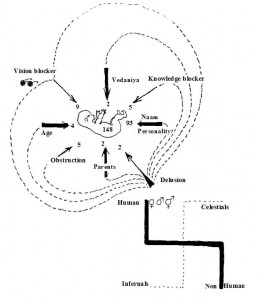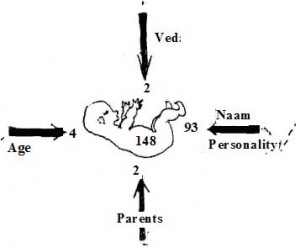16. The eight karmas
All the religions of India believe in karma but in different ways. The Indus religion and culture believes in karma in a very special way. Karma is defined linguistically as work done, that results in its consequences. The so called Hindu religion has well defined karma in the Bhagavad-Gita, where Krishna defines karma as duty without caring for the rewards. The trinity of Brahma, Vishnu and Mahesh (Shiva) – Creator, Sustainer and Destroyer/Renewer commands the existence of world. Whenever a-dharma dominates, Lord Vishnu re-embodies himself and restores dharma, i.e. religion or justice.



Buddhism also considers karma and one has to face its fruits until finally one reaches nirwana from human life. Jainism defines karma not only as work done but also as a collection or aggregate of subtle fragments of matter influencing through its chemistry resulting from thoughts, considers mind and soul in immediate contact to face tension or unrest and again attract new karma. Thoughts rising in any direction from the mind attract karma in the form of fragments even if no action is taken. The action and mind-bound karmas are called dravya karma and bhava karma respectively. In all there are 148 types of karma to understand leading to fruition. However in general they are categorized as of eight types in two groups of four: one of the ghati and the other of the aghati type. Every mundane soul undergoing the cycles of rebirths has always been beclouded by these 8 types of karmas, through their fruits, while constantly creating new ‘clouds’ when they react to the karmic influx to get results under the dulness of ignorance. This belief in 8 karmas (ashtakarma) by Indus people can be seen in their seals is in the way as mentioned in the Jain scriptures. Jinas are sky-clad like newborn human babies and possess

nothing outwardly as well as inwardly. Yet renunciation with full awareness of Jain metaphysics follows in order to counteract the karmas one earned earlier as is also depicted in Indus seal # 321 from Mohenjo-daro:


Reading crisscross over the text of seal # 321 of the Fairservis’ collection shows that under the flag of Kunthunath, (field animal as symbol of the 17th Jina) one can, doing away with the four Dur Dhyans or evil thoughts, as a shrawaka also take the shelter of the 2nd Dharm Dhyan, and begin renunciation with penance observing Ratnatraya, so that one can reach the state of the 4th Shukla Dhyan (on top of the spirituality ladder) to fight off the eight karmas thus achieving salvation. This aspect of Jain culture is also seen in several Indus seals, through depiction of a ladder.

